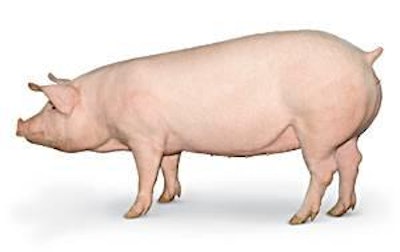
The pioneering spirit that inspired a small bunch of like-minded British pig producers to launch the Pig Improvement Company, PIC, in 1962 is alive and well and driving one of the biggest global pig genetics companies forward into its next 50 years.
Now owned by biotechnology giant Genus plc, which acquired PIC when it bought Sygen in 2005, the company has an annual revenue of £150 million and operates in more than 30 countries on six continents, producing an estimated 100 million market pig equivalents a year.
Taking pig breeding to the next level
Established by a group of pig producers led by Ken Woolley in Oxfordshire, UK in 1962, PIC can list a record of achievements over the half century, starting with its first Camborough gilts, which were delivered in 1964 when the “minimal disease concept” was established.
“It’s amazing what a difference a few like-minded individuals can make on an industry,” says Bill Christianson, Genus America director, who is responsible for PIC (and also celebrates his 50th birthday this year). “I believe that pioneering spirit has driven PIC forward for the past 50 years and it is still the moving force behind this business, which I am confident will continue to remain at the forefront of the pig industry for the next 50 years.”
PIC first ventured out of the UK in 1968, when it established a base in France. Emboldened by its success in Europe, the pig breeding company set up businesses in Canada in 1970, Australia, the United States and Germany in 1973 and then Brazil in 1977, and The rest is, as they say is history.
The company introduced its own PIC pig health scheme in 1969. Medicated early weaning and isolated early weaning followed in 1977 and the Camborough 15 was introduced to the world in 1983. PIC added a recording and analysis system in 1986 and four years later, it was the first pig breeding company to use a DNA probe to test for the halothane gene.
This was followed by the development of three new pig genetic markers for litter size, disease resistance and meat quality in 1998. The turn of the century has seen even further advances on the pig genetic front, with the new Sireline GNXbred (2003), the purchase of Cotswold Swine Genetics in the U.S. (2004) and the new Damline GNXbred (2006). PIC has pioneered single-step genetic evaluations, which suggests that this company has no intention of standing still.
Pig genetics advancements
In an exclusive interview with Pig International, Christianson said, “PIC will continue to select for the pig traits and characteristics that our customers value in a scientific way and with integrity. We still have many people around the world working for PIC, who I believe have the same spirit of the company’s founders and they will lead the way forward as we continue to invest in R&D. We also have a phenomenal database of knowledge, built up by our researchers and commercial pig producers around the world, and we will continue to build on this and use it to improve the robustness and performance of our pigs.”
“Using all the tools we now have available, as well as our massive database, we are always looking at the total economy to ensure we provide products that suit real-world conditions and will work at the commercial level,” he said.
Asked what the company’s “wow factor” is after five decades, Christianson said, “I think it is our accuracy of selection and the use of genomics, which can really make a difference in providing pigs with the traits farmers need to suit different environmental conditions and challenges around the world. Our continued focus on high health, where we have often led the way also is highly valued by the pig industry and our customers.
“We are now more able to get at things that were difficult to select for, such as robustness, litter size, meat quality and plain livability. And, we do this in an open, transparent way with integrity recognizing that the needs of the pig have to play a major role.”
Pig industry maturing
Christianson’s views are supported by PIC UK general manager, Sue Corning, who joined the technical sales department 15 years ago. She says she is still a “techie” at heart and believes the company’s focus on accuracy of selection and use of genomics to obtain full genetic potential from the pigs is very important.
“Here in the UK, many pigs are kept indoors and outdoors,” says Corning. “We are also looking closely at the impact they may have on the environment, especially regarding the future nitrogen/carbon balance.”
She pointed out that the past 50 years have seen enormous changes in what pig farmers want from pig breeding companies.
“In the past, customers just wanted product information – what we had to offer and when they could get it. Now, most of our pig farmers in the more mature markets are looking for tailored genetics to suit their particular businesses, so we are more involved with their long-term planning and help them spot new opportunities.
“We also need to provide more flexibility in the product mix for pig producers who are aiming for particular markets and provide them with more technical support to add value, instead of just selling products. It’s very exciting, because we are much closer to our customers and we are working more closely with the pork supply chain, looking for new opportunities to meet specific requirements of the retail trade.
“At the same time, our eye is always on the total economy and we still focus on our core lines, using genomics and exploiting our international genetic database to identify traits and improve our pigs at the commercial level.”
Explaining that PIC provides what she describes in computer terms as “the intel within a genetic package” – the element that makes it work. Corning is confident PIC will continue to share information among divisions in different countries and its huge database to source new products to help pig producers across the world meet their changing demands successfully.
“Adding value is the new exciting element and it requires closer contact with pig farmers. Instead of just sales staff, we need technical advisory teams to provide an interface with pig producers to help them push forward and develop their businesses in the right direction.”
And with the recent shipment of more than 1,000 high-health breeding pigs from the US to a key account Gvardia in Russia, as well as new opportunities in China, PIC is set to forge ahead for many years as an international leader in providing pig breeding stock and technical support to commercial pig producers around the world.

















